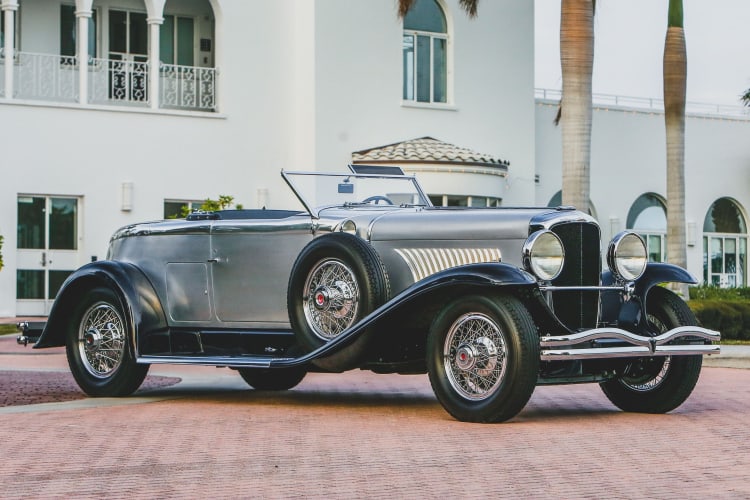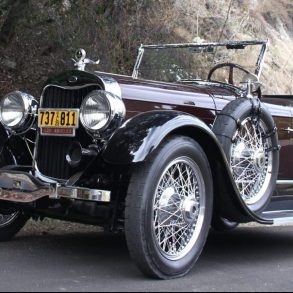Heading to auction on May 22 at the 2021 Amelia Island RM Sotheby’s Auction is a rare 1929 Duesenberg Model J ‘Disappearing Top’ Torpedo by Murphy.
Pasadena-based coachbuilder Walter M. Murphy’s most famous design on the Duesenberg Model J chassis, being the ‘Disappearing Top’ Convertible Coupe, saw only 25 examples of the car produced. Each had a unique convertible top that was neatly put away inside the smooth rear deck when lowered.
However, a much rarer machine, being the ‘Disappearing Top’ Torpedo Convertible Coupe, where only six were constructed, is arguably Murphy’s finest work on the Duesenberg chassis.

It seamlessly blended the convertible coupe’s lines with the graceful and flowing tapered deck of a ‘boattail’ speedster. Often, Murphy completed it in bare aluminum that extended forward through the beltline and down the center of the car’s cowl – allowing it to shine in the Californian sun.
1929 Duesenberg Model J, Chassis 2199
Murphy only produced six units of the ‘Disappearing Top’ Torpedo Convertible Coupe. One was on a single long-wheelbase example, and the other five were built on a short wheelbase.

It is possible that body no. 876, which is on the example, may have been the first, as the example along with body no. 898, which was used on J-198/2221, are both “800-number” bodies which meant that they were made on-spec for Duesenberg and not for individual clients.
The two automobiles displayed an early prototype version of the Murphy Disappearing Top, which was hidden below a low leather tonneau instead of a full metal clamshell lid.
Additionally Body no. 876 features a single-passenger rumble seat in a distinct tail design. The tail flares out at the bottom, extends to the sides, and then curves to the rear fenders, instead of having a clean point like in other examples.

The example is one of the two Torpedo Convertible Coupes that did not have the usual chrome “rub strips” on the rear fenders when it was delivered.
Most distinctly, it was also delivered with bare aluminum coachwork. The sides of the body and most of the hood had a brush-finish while the top of the rear deck, going through the caps of the doors towards the ‘sweep’ of the hood, was presented in a mirror finish.

The striking result in the example brings similarities to the gorgeous Rolls-Royces constructed for certain Maharajas. On the car, only the fenders and valances are painted, given a rich dark blue finish.
According to the research done by the late Duesenberg historian Ray Wolff, the first owner of chassis number 2199 was David Gray of Santa Barbara, California.
In 1903, Mr. Gray’s father, John, was sagacious enough to invest $10,500 in a new automobile company that Henry Ford founded. By 1919, David Gray sold Mr. Ford his stock back for $26 million and lived quite contented for the rest of his life.

In 1933, the Gray Duesenberg was sold to William McDuffie from Los Angeles where like so many of the Duesenbergs in the late 1930s, it was modernized. Elements changed included adding skirted JN-style fenders and smaller 17-inch wheels.
The redesign caught Hollywood’s attention, where it made its silver screen debut in a memorable scene from the movie She Had to Eat.
In the next few years until the late 1940s, it had a few Southern Californian owners, including Robert J. Gottlieb: Beverly Hills attorney and longtime Motor Trend columnist.

William Coverdale acquired the automobile in 1951, who had been an early and longtime Auburn Cord Duesenberg Club member from Waynesville, Ohio.
By the time Mr. Coverdale acquired the example, the original engine, J-178, was absent from the vehicle. It is said that Los Angeles dealer Bob Roberts used the engine for parts. Mr. Coverdale acquired and installed another original Duesenberg engine, J-414, which remains within the example today.


With Mr. Coverdale being able to return the ‘boattail’ to a presentable running order, he was often seen driving the example. Over the years, it was noticed at an early ACD Club meeting in Avon, Pennsylvania, and through the mid-1950s, it would been seen in Auburn. After a long ownership of 34 years, Mr. Coverdale parted with his prized possession in 1985.
Chassis no 2199 was brokered through Bob Adams and Tom Barrett, and for a short time, it was owned by the late Rick Carroll. Eventually, the Blackhawk Collection acquired the Duesenberg, where it went through a restoration process before being presented to the Auburn Cord Duesenberg Club. It was certified Category One, noting that it has kept all the correct Duesenberg components, including the original chassis frame, bodywork, and firewall.

In 2015, the current owner acquired the Duesenberg, where it underwent a complete, Concours-quality restoration under the expertise of RM Auto Restoration.
After some research, the original bare brushed aluminum finish was restored, while the surviving Murphy factory and period photographs of the example enabled them to return its original trim, which was changed by its previous owners.

Due to their expertise, RM was able to retain most of the original aluminum sheet metal, as they tried to preserve it wherever possible, no matter the cost.
It made its Concours-quality restoration debut at the 2019 Pebble Beach Concours d’Elegance, where despite the strong competition, it was awarded Second in Class. At the 2020 Amelia Island Concours d’Elegance, it achieved Best in Class.
Further details of the 1929 Duesenberg Model J ‘Disappearing Top’ Torpedo by Murphy can be found at RM Sotheby’s.
[Source: RM Sotheby’s]











The polished area may be a brilliant reflection on Murphy Coachbuilders, and even without a supercharger Duesenbergs were blindingly fast, but I wonder if tinted goggles, or at least sun glasses, are provided for the rumble seat passenger.